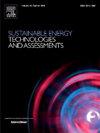Experimental study on preparing Cu/TiO2 photothermal catalysts using photodeposition one-step method and its application in catalytic hydrogen production from glycerol
IF 7.1
2区 工程技术
Q1 ENERGY & FUELS
Sustainable Energy Technologies and Assessments
Pub Date : 2025-01-01
DOI:10.1016/j.seta.2024.104144
引用次数: 0
Abstract
In the study, a novel photodeposition one-step method for preparing Cu/TiO2 photothermal catalysis was proposed to catalyze hydrogen production from glycerol. The biomass glycerol was used as a sacrificial agent to provide electrons for Cu2+ loading during the catalyst preparation stage, and the remaining biomass glycerol was used directly as a reactant for photothermal-catalyzed hydrogen production. The catalysts were characterized using XRD, SEM, and TEM to obtain their phases and structures. The Cu/TiO2 photodeposition process evaluation method based on image analysis and processing, and its experimental platform were established. The influence of parameters such as irradiation intensity, temperature, and catalyst concentration on the loading rate of photodeposited Cu2+ was analyzed. The results demonstrated that enhancing the irradiation intensity, increasing the temperature, and decreasing the catalyst concentration can increase the loading rate of Cu. The Cu/TiO2 photothermal catalyst prepared by this method showed a hydrogen production rate 1.6 times higher than that of the deposition and precipitation method under the same reaction conditions, which proved that the catalyst had a high photothermal catalysis hydrogen production activity. The hydrogen production rate at an irradiation intensity of 250 mW/cm2 was 628.16 μmol/(g·h), which was 1.9 times that at an irradiation intensity of 100 mW/cm2. Both elevated temperature and increased irradiation intensity can significantly improve the photothermal catalysis glycerol hydrogen production activity.
求助全文
约1分钟内获得全文
求助全文
来源期刊

Sustainable Energy Technologies and Assessments
Energy-Renewable Energy, Sustainability and the Environment
CiteScore
12.70
自引率
12.50%
发文量
1091
期刊介绍:
Encouraging a transition to a sustainable energy future is imperative for our world. Technologies that enable this shift in various sectors like transportation, heating, and power systems are of utmost importance. Sustainable Energy Technologies and Assessments welcomes papers focusing on a range of aspects and levels of technological advancements in energy generation and utilization. The aim is to reduce the negative environmental impact associated with energy production and consumption, spanning from laboratory experiments to real-world applications in the commercial sector.
 求助内容:
求助内容: 应助结果提醒方式:
应助结果提醒方式:


